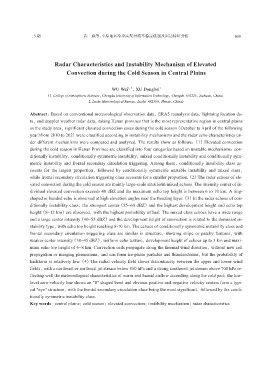Page 251 - 《高原气象》2025年第3期
P. 251
3 期 武 威等:中原地区冷季高架对流不稳定机制及雷达特征分析 809
Radar Characteristics and Instability Mechanism of Elevated
Convection during the Cold Season in Central Plains
WU Wei , XU Dongbei 1
1, 2
(1. College of Atmospheric Sciences, Chengdu University of Information Technology, Chengdu 610225, Sichuan, China;
2. Luohe Meteorological Bureau, Luohe 462300, Henan, China)
Abstract: Based on conventional meteorological observation data, ERA5 reanalysis data, lightning location da‐
ta, and doppler weather radar data, taking Henan province that is the most representative region in central plains
as the study area, significant elevated convection cases during the cold season (October to April of the following
year)from 2010 to 2021 were classified according to instability mechanisms and the radar echo characteristics un‐
der different mechanisms were compared and analyzed. The results show as follows: (1) Elevated convection
during the cold season in Henan Province are classified into four categories based on unstable mechanisms: con‐
ditionally instability, conditionally symmetric instability, mixed conditionally instability and conditionally sym‐
metric instability and frontal secondary circulation triggering. Among them, conditionally instability class ac‐
counts for the largest proportion, followed by conditionally symmetric unstable instability and mixed class,
while frontal secondary circulation triggering class accounts for a smaller proportion.(2) The radar echoes of ele‐
vated convection during the cold season are mainly large-scale stratiform mixed echoes. The intensity center of in‐
dividual elevated convection exceeds 40 dBZ and the maximum echo top height is between 6 to 10 km. A ring-
shaped or banded echo is observed at high elevation angles near the freezing layer.(3) In the radar echoes of con‐
ditionally instability class, the strongest center (55~60 dBZ) and the highest development height and echo top
height (8~12 km) are observed, with the highest probability of hail. The mixed class echoes have a wide range
and a large center intensity (40~55 dBZ) and the development height of convection is related to the dominant in‐
stability type, with echo top height reaching 8-10 km. The echoes of conditionally symmetric instability class and
frontal secondary circulation triggering class are similar in structure, showing stripe or patchy features, with
weaker center intensity (30~45 dBZ), uniform echo texture, development height of echoes up to 3 km and maxi‐
mum echo top height of 6~8 km. Convection cells propagate along the thermal wind direction, without new cell
propagation or merging phenomena, and can form ice-phase particles and thunderstorms, but the probability of
hailstorm is relatively low.(4) The radial velocity field shows discontinuity between the upper and lower wind
fields, with a northeast or northeast jet stream below 850 hPa and a strong southwest jet stream above 700 hPa re‐
flecting well the meteorological characteristics of warm and humid airflow ascending along the cold pad; the low-
level zero-velocity line shows an "S" shaped bend and obvious positive and negative velocity centers form a typi‐
cal "eye" structure, with the frontal secondary circulation class being the most significant, followed by the condi‐
tionally symmetric instability class.
Key words: central plains; cold season; elevated convection; instability mechanism; radar characteristics

